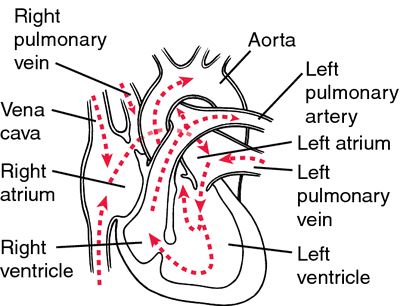Biliary Atresia
Definition
Biliary atresia is the failure of a fetus to develop an adequate pathway for bile to drain from the liver to the intestine.
Description
Biliary atresia is the most common lethal liver disease in children, occurring once every 10,000-15,000 live births. Half of all liver transplants are done for this reason.
The normal anatomy of the bile system begins within the liver, where thousands of tiny bile ducts collect bile from liver cells. These ducts merge into larger and larger channels, like streams flowing into rivers, until they all pour into a single duct that empties into the duodenum (first part of the small intestine). Between the liver and the duodenum this duct has a side channel connected to the gall bladder. The gall bladder stores bile and concentrates it, removing much of its water content. Then, when a meal hits the stomach, the gall bladder contracts and empties its contents.
Bile is a mixture of waste chemicals that the liver removes from the circulation and excretes through the biliary system into the intestine. On its way out, bile assists in the digestion of certain nutrients. If bile cannot get out because the channels are absent or blocked, it backs up into the liver and eventually into the rest of the body. The major pigment in bile is a chemical called bilirubin, which is yellow. Bilirubin is a breakdown product of hemoglobin (the red chemical in blood that carries oxygen). If the body accumulates an excess of bilirubin, it turns yellow (jaundiced). Bile also turns the stool brown. Without it, stools are the color of clay.
Causes and symptoms
It is possible that a viral infection is responsible for this disease, but evidence is not yet convincing. The cause remains unknown.
The affected infant will appear normal at birth and during the newborn period. After two weeks the normal jaundice of the newborn will not disappear, and the stools will probably be clay-colored. At this point, the condition will come to the attention of a physician. If not, the child's abdomen will begin to swell, and the infant will get progressively more ill. Nearly all untreated children will die of liver failure within two years.
Diagnosis
The persistence of jaundice beyond the second week in a newborn with clay-colored stools is a sure sign of obstruction to the flow of bile. An immediate evaluation that includes blood tests and imaging of the biliary system will confirm the diagnosis.
Treatment
Surgery is the only treatment. Somehow the surgeon must create an adequate pathway for bile to escape the liver into the intestine. The altered anatomy of the biliary system is different in every case, calling upon the surgeon's skill and experience to select and execute the most effective among several options. If the obstruction is only between the gall bladder and  the intestine, it is possible to attach a piece of intestine directly to the gall bladder. More likely, the upper biliary system will also be inadequate, and the surgeon will attach a piece of intestine directly to the liver—the Kasai procedure. In its wisdom, the body will discover that the tiny bile ducts in that part of the liver are discharging their bile directly into the intestine. Bile will begin to flow in that direction, and the channels will gradually enlarge. Survival rates for the Kasai procedure are commonly 50% at five years and 15% at 10 years. Persistent disease in the liver gradually destroys the organ.
the intestine, it is possible to attach a piece of intestine directly to the gall bladder. More likely, the upper biliary system will also be inadequate, and the surgeon will attach a piece of intestine directly to the liver—the Kasai procedure. In its wisdom, the body will discover that the tiny bile ducts in that part of the liver are discharging their bile directly into the intestine. Bile will begin to flow in that direction, and the channels will gradually enlarge. Survival rates for the Kasai procedure are commonly 50% at five years and 15% at 10 years. Persistent disease in the liver gradually destroys the organ.

Biliary atresia is a congenital condition in which the pathway for bile to drain from the liver to the intestine is undeveloped. It is the most common lethal liver disease in children.
(Illustration by Electronic Illustrators Group).
Prognosis
Before liver transplants became available, even prompt and effective surgery did not cure the whole problem. Biliary drainage can usually be established, but the patients still have a defective biliary system that develops progressive disease and commonly leads to an early death. Transplantation now achieves up to 90% one-year survival rates and promises to prevent the chronic disease that used to accompany earlier procedures.
Key terms
Duodenum — The first part of the small intestine, beginning at the outlet of the stomach.
Hemoglobin — The red, iron-containing chemical in the blood that carries oxygen to the tissues.
Jaundice — The yellow color taken on by a patient whose liver is unable to excrete bilirubin. A normal condition in the first week of life due to the infant's delayed ability to process certain waste products.
Kernicterus — A potentially lethal disease of newborns caused by excessive accumulation of the bile pigment bilirubin.
Prevention
The specific cause of this birth defect is unknown, so all that women can do is to practice the many general preventive measures, even before they conceive.
Biliary atresia is a congenital condition in which the pathway for bile to drain from the liver to the intestine is undeveloped. It is the most common lethal liver disease in children.
Resources
Books
Feldman, Mark, et al. "Diseases of the Bile Ducts." Sleisenger & Fordtran's Gastrointestinal and Liver Disease. Philadelphia: W. B. Saunders Co., 1998.
Gale Encyclopedia of Medicine. Copyright 2008 The Gale Group, Inc. All rights reserved.
atresia
[ah-tre´zhah]congenital absence or closure of a normal body opening or tubular structure; see also obstruction. adj., adj atret´ic.
anal atresia (atresia a´ni) imperforate anus.
aortic atresia
1. congenital absence of the aortic orifice.
2. absence or closure of the aortic orifice, a rare congenital anomaly in which the left ventricle is hypoplastic, so that oxygenated blood passes from the left into the right atrium through a septal defect, and the mixed venous and arterial blood passes from the pulmonary artery to the aorta by way of a patent ductus arteriosus.
aural atresia absence of closure of the auditory canal.
biliary atresia congenital obliteration or hypoplasia of one or more components of the bile ducts, resulting in persistent jaundice and liver damage.
choanal atresia blockage of the posterior nares. When the blockage is bilateral in a newborn, it produces acute respiratory distress because neonates are nose-breathers. Diagnosis is confirmed if a catheter cannot be passed through the nares. Until surgery is done to relieve the obstruction, insertion of an airway may be necessary.
esophageal atresia congenital lack of continuity of the esophagus, commonly accompanied by tracheoesophageal fistula, and characterized by accumulations of mucus in the nasopharynx, gagging, vomiting when fed, cyanosis, and dyspnea. Treatment should begin with suction of the upper esophageal pouch, followed by surgical repair by esophageal anastomosis and division of the fistula as soon as the infant's general condition permits.
follicular atresia (atresia folli´culi) the normal death of the ovarian follicle when unfertilized.
laryngeal atresia congenital lack of the normal opening into the larynx.
mitral atresia congenital obliteration of the mitral orifice; it is associated with hypoplastic left heart syndrome and transposition of great vessels.
prepyloric atresia congenital membranous obstruction of the gastric outlet, characterized by vomiting of gastric contents only. Called also pyloric atresia.
pulmonary atresia congenital severe narrowing or obstruction of the pulmonary orifice, with cardiomegaly, reduced pulmonary vascularity, and right ventricular atrophy. It is usually associated with tetralogy of fallot, transposition of great vessels, or other cardiovascular anomalies.
pyloric atresia prepyloric atresia.
tricuspid atresia absence of the tricuspid orifice, circulation being made possible by an atrial septal defect.

Tricuspid atresia, here displaying a ventricular septal defect and normally related great arteries, the arrows showing the altered flow of blood through the heart. From Dorland's, 2000.
urethral atresia imperforation of the urethra.
Miller-Keane Encyclopedia and Dictionary of Medicine, Nursing, and Allied Health, Seventh Edition. © 2003 by Saunders, an imprint of Elsevier, Inc. All rights reserved.
bil·i·ar·y a·tre·si·a
atresia of the major bile ducts, causing cholestasis and jaundice, which does not become apparent until several days after birth; periportal fibrosis develops and leads to cirrhosis, with proliferation of small bile ducts unless these are also atretic; giant cell transformation of hepatic cells also occurs. Compare: neonatal hepatitis.
Farlex Partner Medical Dictionary © Farlex 2012
biliary atresia
A rare condition caused by an abnormal development of intrahepatic or extrahepatic bile ducts; obstruction of bile flow from the liver can lead to cirrhosis if untreated.Clinical findings
Jaundice in 2nd to 3rd week of life, clay-coloured stools.
Segen's Medical Dictionary. © 2012 Farlex, Inc. All rights reserved.
biliary atresia
Gastroenterology A rare condition caused by an abnormal development of intrahepatic or extrahepatic bile ducts; obstruction of bile flow from the liver can lead to cirrhosis if untreated Clinical Jaundice in 2nd to 3rd wk of life, clay-colored stools. See Neonatal jaundice, Newborn jaundice.McGraw-Hill Concise Dictionary of Modern Medicine. © 2002 by The McGraw-Hill Companies, Inc.
bil·i·ar·y a·tre·si·a
(bil'ē-ar-ē ă-trē'zē-ă)Atresia of the major bile ducts, causing cholestasis and jaundice, which does not become apparent until several days after birth; periportal fibrosis develops and leads to cirrhosis, with proliferation of small bile ducts and giant cell transformation of hepatic cells.
Compare: neonatal hepatitis
Compare: neonatal hepatitis
Medical Dictionary for the Health Professions and Nursing © Farlex 2012
biliary atresia
A congenital disorder in which the larger branches of the bile ducts are so narrowed that the bile cannot escape and the baby becomes severely jaundiced with enlargement of the liver. Recent studies suggest that defects in expression of the villin gene may be implicated.Collins Dictionary of Medicine © Robert M. Youngson 2004, 2005
bil·i·ar·y a·tre·si·a
(bil'ē-ar-ē ă-trē'zē-ă)Atresia of the major bile ducts, causing cholestasis and jaundice, which does not become apparent until several days after birth; periportal fibrosis develops and leads to cirrhosis, with proliferation of small bile ducts and giant cell transformation of hepatic cells.
Medical Dictionary for the Dental Professions © Farlex 2012